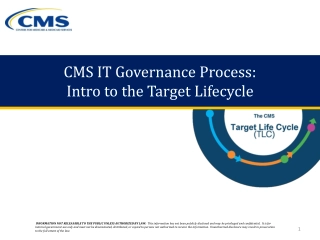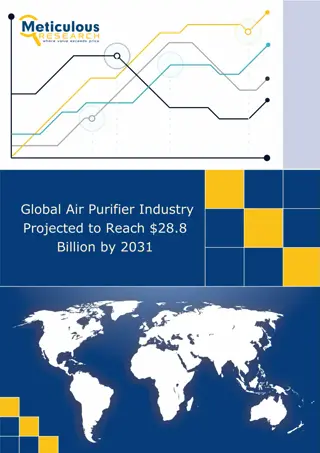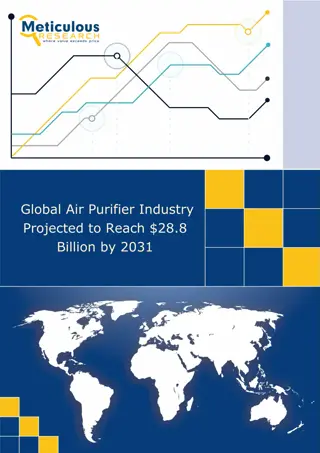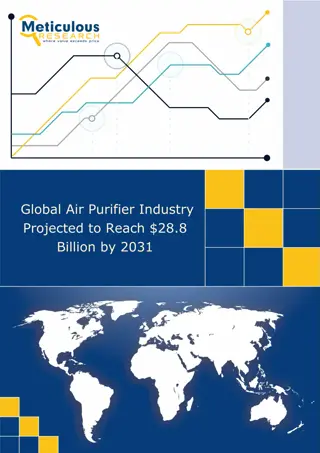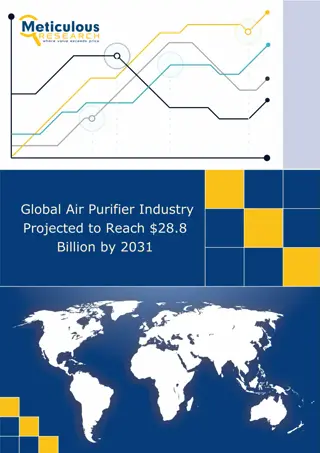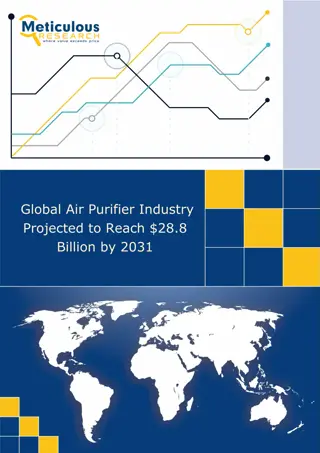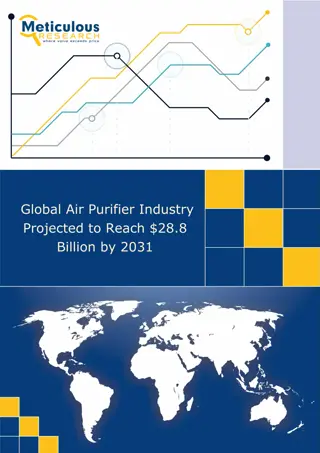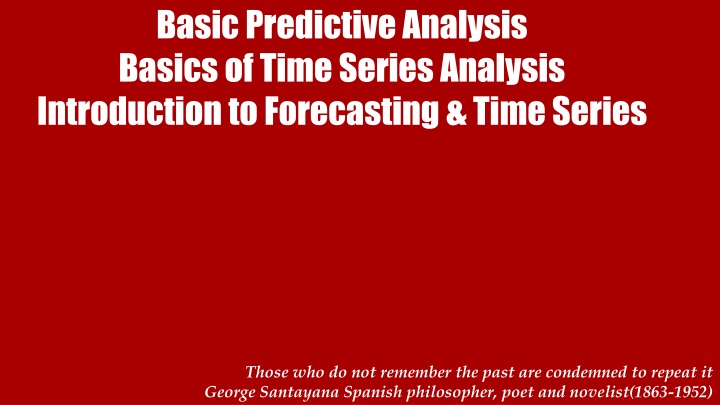
Introduction to Time Series Analysis and Forecasting
"Learn the basics of time series analysis, forecasting, and the importance of historical data. Discover how forecasting plays a crucial role in business processes and explore the characteristics of forecasting techniques. Dive into the world of containerized cargo handling to understand global trends. Enhance your knowledge with insights from experts in the field."
Download Presentation

Please find below an Image/Link to download the presentation.
The content on the website is provided AS IS for your information and personal use only. It may not be sold, licensed, or shared on other websites without obtaining consent from the author. If you encounter any issues during the download, it is possible that the publisher has removed the file from their server.
You are allowed to download the files provided on this website for personal or commercial use, subject to the condition that they are used lawfully. All files are the property of their respective owners.
The content on the website is provided AS IS for your information and personal use only. It may not be sold, licensed, or shared on other websites without obtaining consent from the author.
E N D
Presentation Transcript
Basic Predictive Analysis Basics of Time Series Analysis Introduction to Forecasting & Time Series Those who do not remember the past are condemned to repeat it George Santayana Spanish philosopher, poet and novelist(1863-1952)
Introduction to Forecasting and Time Series Moving Average, A. Asef-Vaziri, Systems & Operations Management 2
All Business Processes & Functions Need Forecasting Forecast: a prediction of the future value of a variable of interest, such as demand. Marketing, finance, and operations are the three key building blocks of manufacturing and service organizations. They all need forecasting for planning, organizing, and budgeting. current market demand, long-term trends, seasonality, understanding the relationship between price and demand, sales force planning, etc. revenue and cost analysis, cash flow planning, investment analysis, etc. capacity planning, inventory management, operations planning, break-even analysis, etc. hiring, recruiting, training, etc. Marketing Finance Operations Human Resources Moving Average, A. Asef-Vaziri, Systems & Operations Management 3
Four Characteristics of All Forecasting Techniques Forecasts are almost always inaccurate- Differ from actual. Forecasts should be accompanied by a measure of forecast error- such as standard deviation or coefficient of variation. Forecasts for aggregate items are more accurate than individual forecasts. Aggregate forecasts reduce the amount of variability relative to the aggregate mean demand. Standard deviation of sum of two variables is less than sum of the standard deviation of the two variables. Long-range forecasts are less accurate than short-range forecasts. Forecasts further into the future tends to be less accurate than those of more imminent events. As time passes, we get better information, and make better prediction. Moving Average, A. Asef-Vaziri, Systems & Operations Management 4
World Containerized Cargo-2016 World Container Handling Port Ranking World Container Handling Country Ranking Million TEUs (Twenty-Foot Equivalent Units) Million TEUs (Twenty-Foot Equivalent Units) Rank 1 2 3 4 5 6 7 8 9 10 (a) Port Country China Singapore China China China South Korea China China U.A. Emirates USA Top 10 ports: 37% MTEUs 36.5 30.9 24.1 20.6 20.1 19.5 17.3 17.1 15.6 15.4 Rank 1 2 3 4 5 6 7 8 9 10 (b) Country China United States Singapore South Korea Malaysia United Arab Emirates Taiwan Germany Netherlands Belgium MTEUs % to World 168.9 45.5 30.9 24.5 22.0 20.0 14.4 14.4 12.2 11.2 Top 10 countries: 70% Shanghai Singapore Shenzhen Ningbo Hong Kong Busan Qingdao Guangzhou Dubai Ports LA/LB 32.4% 8.7% 5.9% 4.7% 4.2% 3.8% 2.8% 2.8% 2.3% 2.2% Moving Average, A. Asef-Vaziri, Systems & Operations Management 5
US-China Alternative Routes Narvik, Norway Prince Rupert, Canada Vostochny, Russia New York New York Rotterdam, Netherlands Norfolk Norfolk Los Angeles Savannah Savannah Hong Kong, China Ensenada, Mexico Colima, Mexico Singapore Moving Average, A. Asef-Vaziri, Systems & Operations Management 6
Aggregate Forecasts Are More Accurate 4 Weeks 2 Weeks 3 Weeks Moving Average, A. Asef-Vaziri, Systems & Operations Management 7
Forecasts More into Future Are Less Accurate 2-3 days 3-4 days 14 days Moving Average, A. Asef-Vaziri, Systems & Operations Management 8
Delphi: A Qualitative Forecasting Method Non-quantitative forecasting techniques based on expert opinions and intuition. Typically used when there are no data available. Delphi Method Subjective, judgmental Based on intuition, estimates, and opinions Expert Opinions Market Research Historical Analogies Moving Average, A. Asef-Vaziri, Systems & Operations Management 9
Types of Forecasting- Time Series Quantitative Techniques Time Series Analysis - Analyzing the data on a variable of interest (such as sales, demand, etc.) measured at successive time periods. Moving Average Weighted Moving Average Exponential Smoothing Regression Analysis - Relating a dependent variable (demand) to other independent variables (time, price, income, etc.) Linear Single-Variable or Multi-Variables Nonlinear - Single-Variable or Multi-Variables Time Series or Causal Measures of Accuracy Mean Absolute Deviation (MAD) Mean Squared Error (MSE) Mean Absolute Relative Deviation (MARD) [Mean Absolute Percentage Error (MAPE)] Tracking Signal (TS) Moving Average, A. Asef-Vaziri, Systems & Operations Management 10
Systematic & Random Variations - LA/LB Ports 23 Years TEUs Time Series. A relationship between the variable of interest demand - and time. Systematic Components (Expected) Level (current deseasonalized Trend (growth or decline) Seasonality (less than one year) Cycles (every several years) Random Components (Not Predictable) Cycles 1,200 1,000 Trend 800 Seasonality Level 600 400 Moving Average, A. Asef-Vaziri, Systems & Operations Management 11
Historical forecast performance Initial forecast =2000 units. Actual Forecast Error(A-F)Ratio(A/F) 107 189 227 94 195 185 190 309 -101 306 141 100 207 461 -133 454 -113 504 -137 417 433 268 232 466 432 126 812 -251 921 -170 676 169 1090 -180 1301 108 2244 -426 1047 833 1849 1487 621 1508 1093 4181 -1302 756.70 14.83 854.23 392.96 1.13 26.49 Forecast vs Actual Forecast vs Actual Product-1 Product-2 Product-3 Product-4 Product-5 Product-6 Product-7 Product-8 Product-9 Product-10 Product-11 Product-12 Product-13 Product-14 Product-15 Product-16 Product-17 Product-18 Product-19 Product-20 Product-21 Product-22 Product-23 Product-24 Product-25 Product-26 Product-27 Product-28 Product-29 Product-30 Average StdDev CV 100 135 157 167 169 173 195 208 235 241 262 328 341 367 390 425 500 538 558 561 751 845 910 1409 1818 1880 1895 2108 2601 2879 771.53 797.00 1.03 -7 0.93 0.71 0.69 1.78 0.87 0.94 1.03 0.67 0.77 1.71 1.27 0.71 0.75 0.73 0.94 0.98 1.87 1.15 1.29 0.69 0.82 1.25 0.83 1.08 0.81 1.80 1.02 1.42 1.72 0.69 1.06 0.38 0.36 -54 -70 73 -26 -12 4500 4000 3500 3000 2500 5 2000 1500 -71 1000 500 55 0 0 500 1000 1500 2000 2500 3000 3500 4000 4500 Average A/F Ratio 1.06 StdDev A/F= 0.38 "Expected actual demand "= 1.06(2000) "Standard deviation of actual demand"= "Standard deviation of A/F ratios " "Forecast" =0.38*2000= 760 A~N(2120,760) -27 -8 72 46 Moving Average, A. Asef-Vaziri, Systems & Operations Management 12
Ports of LOS Angeles & Log Beach Monthly Data (1000s TEUs) TEU: Twenty-Foot Equivalent Unit A 20 feet intermodal container. We use this data in our Predictive Analytics Assignment. You may open the Table below 1997 1998 1999 2000 2001 2002 2003 2004 2005 2006 2007 2008 2009 2010 2011 2012 2013 2014 2015 2016 2017 2018 2019 480 527 589 698 873 907 853 993 1100 1200 1283 1173 J 986 1002 1135 1155 1205 1214 959 1241 1409 1467 1466 F 468 512 588 672 853 991 864 797 1052 996 1191 1143 732 939 1013 914 1146 1077 916 1275 1124 1387 1322 M 504 608 624 708 924 1015 920 1060 991 1232 1171 1082 901 973 1013 1112 990 1153 1422 1078 1294 1153 1131 A 518 611 623 773 956 1033 990 1058 1175 1293 1259 1162 941 1080 1148 1169 1160 1276 1278 1135 1273 1324 1334 M 529 632 730 815 1020 1079 1040 1129 1175 1340 1288 1216 995 1214 1230 1229 1220 1289 1330 1411 1445 1456 1343 J 556 640 691 778 927 1035 950 1106 1211 1344 1378 1212 965 1251 1195 1252 1212 1347 1305 1279 1390 1475 1400 J 568 658 678 851 995 1016 1047 1206 1222 1344 1364 1262 1009 1319 1261 1249 1278 1300 1389 1325 1517 1522 1456 A 557 686 747 899 1057 1079 1042 1148 1267 1466 1373 1329 1106 1375 1259 1250 1340 1331 1490 1440 1540 1506 1491 S 589 663 740 810 1011 929 1003 1087 1274 1406 1397 1248 1024 1286 1233 1257 1298 1405 1386 1295 1465 1503 1508 O 583 659 784 914 1106 865 1108 1201 1309 1451 1380 1302 1100 1296 1200 1249 1261 1299 1325 1396 1418 1658 1641 N 556 667 745 825 1000 876 1053 1213 1252 1401 1348 1218 1028 1225 1154 1139 1253 1245 1330 1412 1537 1454 1432 D You may use the following formula to turn the matrix into a column. =INDEX($B$2:$X$13,IF(MOD(ROWS(B$17:B17),12)>0,MOD(ROWS(B$17:B17),12),12),IF(INT(ROWS(B$17: B17)/12)<>ROWS(B$17:B17)/12,INT(ROWS(B$17:B17)/12)+1,INT(ROWS(B$17:B17)/12))) 556 614 700 739 922 881 969 1103 1167 1288 1237 991 1030 1136 1159 1148 1236 1226 1223 1346 1476 1645 1568 Moving Average, A. Asef-Vaziri, Systems & Operations Management 13
Snapshot vs Time Series Prescriptive vs Predictive Analytics These data were generated using the procedure in columns AB to AI Per. StationaryTrend Trend&Seas Seas-No-Trend16 - 24 1 23 16 16 2 87 23 30 3 37 24 42 4 58 25 26 5 32 26 25 6 64 26 32 7 59 27 41 8 55 27 24 9 50 28 28 10 68 28 44 11 40 30 44 12 16 30 34 13 60 30 33 14 32 32 36 15 56 32 53 16 54 33 28 17 28 33 26 18 50 34 37 19 37 34 63 20 34 35 30 21 27 36 36 22 46 36 37 23 47 36 53 24 46 36 23 25 46 36 40 26 98 36 47 27 44 37 47 28 41 37 45 29 36 38 34 30 65 40 42 31 26 41 51 32 58 41 47 33 35 42 27 34 30 42 55 35 27 42 59 36 24 43 46 37 26 44 44 38 42 44 43 39 87 44 60 40 83 44 27 41 60 45 47 42 30 46 46 43 72 46 56 Range LB UB CumCount Count Freq CumFreq Statistics Set 1 Set 2 Set 3 Set 4 =RANDBETWEEN(INT((ROWS($AC$3:AC15)/($AA$2)))*$AA$2,(INT((ROWS($AC$3:AC15)/($AA$2))+1)*$AA$2-1)) 16 24 2 2 0.02 0.02 Mean 47.4167 47.4167 47.4167 47.4167 Width (Range/10) 8 44 54 60 34 28 53 59 26 41 82 54 16 33 87 68 34 42 47 87 41 25 64 53 42 32 58 98 30 23 48 50 27 44 86 46 45 42 47 72 27 36 49 55 24 - 32 24 32 13 11 0.13 0.15 Median 46.00 46.00 46.00 46.00 Width (Round) 8 32 - 40 32 40 29 16 0.19 0.35 Max 98.0000 98.0000 98.0000 98.0000 Min (Round) 16 40 - 48 40 48 52 23 0.27 0.62 Min 16.0000 16.0000 16.0000 16.0000 Max How Many Width 13 48 - 56 48 56 63 11 0.13 0.75 Range 82.0000 82.0000 82.0000 82.0000 Max (Round) 104 56 - 64 56 64 71 8 0.10 0.85 StdDev 16.9892 16.9892 16.9892 16.9892 Periodicity 4 64 - 72 64 72 76 5 0.06 0.90 CV 0.3583 0.3583 0.3583 0.3583 72 - 80 72 80 77 1 0.01 0.92 Mean/Median 1.030797 1.030797 1.030797 1.030797 80 - 88 80 88 83 6 0.07 0.99 Range/Mean 1.7293 1.7293 1.7293 1.7293 88 - 96 88 96 83 0 0.00 0.99 96 - 104 96 104 84 1 0.01 1.00 104 - 112 104 112 84 0 0.00 1.00 112 - 120 112 120 84 0 0.00 1.00 84 1.00 Trend&Seas Seas-No-Trend Trend Stationary 0.30 0.30 0.30 0.30 0.25 0.25 0.25 0.25 0.20 0.20 0.20 0.20 0.15 0.15 0.15 0.15 0.10 0.10 0.10 0.10 0.05 0.05 0.05 0.05 0.00 0.00 0.00 0.00 16 - 24 24 - 32 32 - 40 40 - 48 48 - 56 56 - 64 64 - 72 72 - 80 80 - 88 88 - 96 96 - 104 104 - 112 112 - 120 16 - 24 24 - 32 32 - 40 40 - 48 48 - 56 56 - 64 64 - 72 72 - 80 80 - 88 88 - 96 96 - 104 104 - 112 112 - 120 16 - 24 24 - 32 32 - 40 40 - 48 48 - 56 56 - 64 64 - 72 72 - 80 80 - 88 88 - 96 96 - 104 104 - 112 112 - 120 16 - 24 24 - 32 32 - 40 40 - 48 48 - 56 56 - 64 64 - 72 72 - 80 80 - 88 88 - 96 96 - 104 104 - 112 112 - 120 Stationary Seas-No-Trend Trend Trend&Seas 120 120 120 120 100 100 100 100 80 80 80 80 60 60 60 60 40 40 40 40 20 20 20 20 0 0 0 0 0 20 40 60 80 0 20 40 60 80 0 20 40 60 80 0 20 40 60 80 Moving Average, A. Asef-Vaziri, Systems & Operations Management 14

